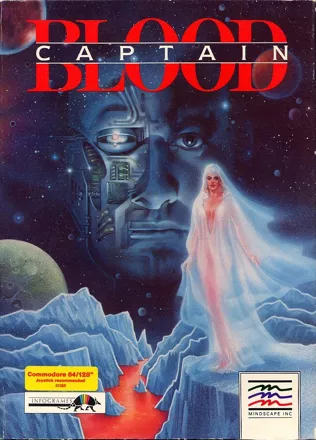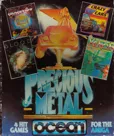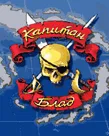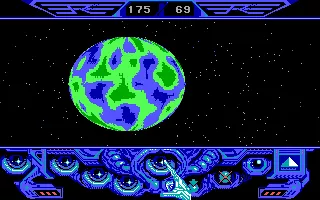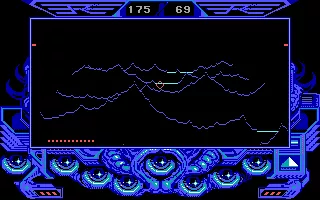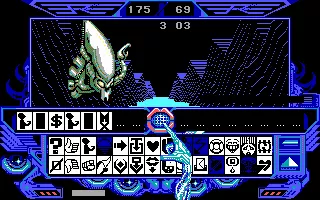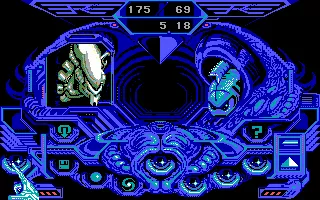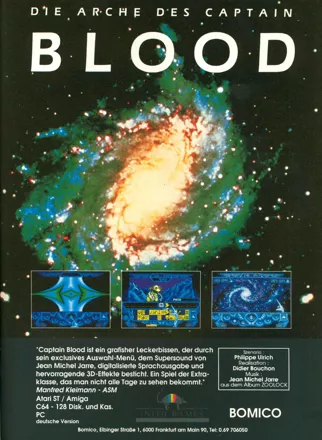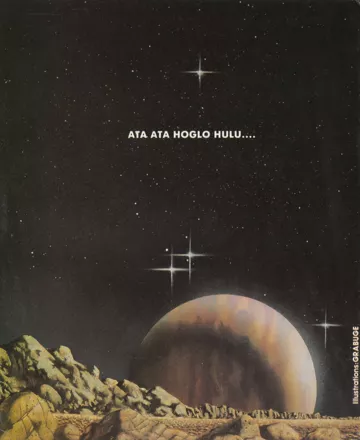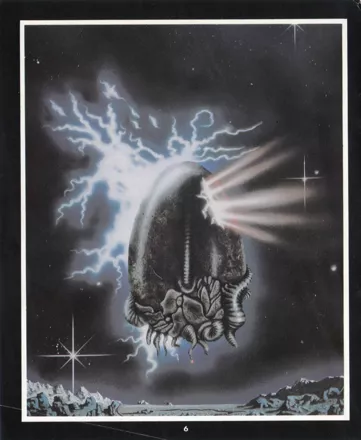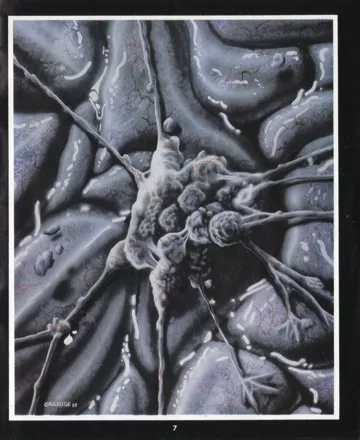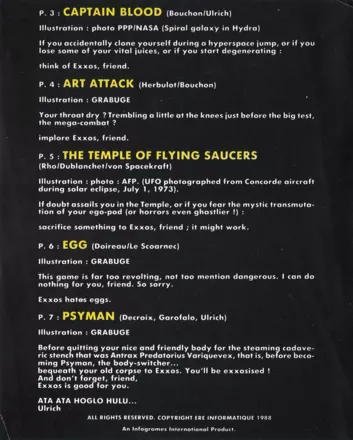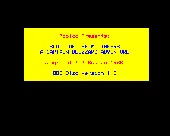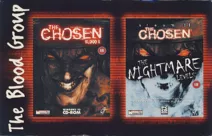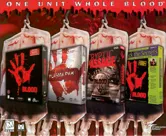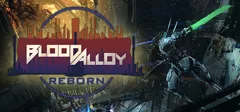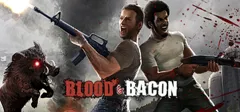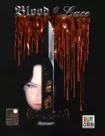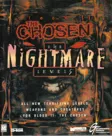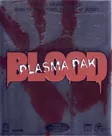Captain Blood
Description official description
Bob Morlock is a game designer who has just developed a new sci-fi video game set in outer space and alien worlds. While testing the product Morlock inexplicably finds himself in the spaceship within the game. A hyperspace accident clones him thirty times. Each of the clones departs, taking with him a portion of a vital fluid that sustains Morlock's life. Assuming the persona of the brave Captain Blood, the programmer tracked down and disintegrated twenty-five clones, spending 800 years to achieve that goal. However, five clones still remain, hidden somewhere in the depths of the galaxy. Captain Blood must find these clones and destroy them before he loses his own life.
Captain Blood is an open-ended first-person adventure game. Much of the game consists of traveling to various planets and communicating with the aliens there to gather clues concerning the clones' whereabouts. The player commands a biological ship called Ark, and must launch probes onto planet surfaces, successfully navigating them through the landscape to locate an alien. The Ark can also scan planets and sometimes teleport aliens to different locations.
Conversations with the aliens are conducted via the so-called UPCOM interface. Over 150 icons are available to represent different concepts. Since each alien speaks their own language, the player must input various combinations of the icons to be able to understand the alien and communicate with them. Successfully concluding conversations may offer clues or unlock other planets. The protagonist's health deteriorates over the time, which affects the game's interface by making it more difficult to control. These symptoms may be reverted by disintegrating a clone.
Groups +
Screenshots
Promos
Credits (DOS version)
7 People
| Lead Design | |
| Lead Programming | |
| Programming | |
| Graphics / Artwork | |
| Music | |
| Original music, from Jean-Michel Jarre's album "Zoolook" (1984) |
|
| "Ethnicolor" by |
Reviews
Critics
Average score: 84% (based on 27 ratings)
Players
Average score: 3.5 out of 5 (based on 71 ratings with 3 reviews)
"An incandescent meteor tore through space with a scissors sound"
The Good
Captain Blood was one of the epics, and back in 1988 it was one of the best reasons for ditching your 8-bit machine and buying an Atari ST or Commodore Amiga instead.
The game was released at a time when the 16-bit machines were still quite new, and there was a sense of boundless possibilities and distant frontiers. As a game Captain Blood has nothing going for it, but it wasn't a game, really; it was an experience. It had a spacey, eccentric atmosphere and it was very stylish, with a moody blue colour scheme and some glowing special effects.
The gameplay boiled down to two elements. Firstly, you flew through a jagged fractal canyon, reminiscent of "Rescue on Fractalus" but with less freedom of motion. It was clear that the designers had come up with a fractal canyon routine but had no idea of how to turn it into a game, but no matter. The canyon run was smooth and fast. It looked stylish, and still looks stylish in 2005. As with Starglider and Battlezone, the vector graphics transcended fashion and still look "futuristic".
The meat of the game was an ELIZA-like conversation simulator, in which you used a long strip of icons to talk with alien beings. You would say things such as ME BLOOD SPACESHIP HOME FRIEND FRIEND CODE and the aliens would say ME IZWAL FEAR SPACESHIP YOU GREAT BLOOD and you would say TELEPORT SPACESHIP ONDOYANTE YES and they would say BIG FRIEND TORKA HA HA HA and you would say DIE EVIL NO PLANET BIG FRIEND PRISON and they would say HA HA HA and eventually you would get bored with this and enter random characters until the alien gave you a pair of co-ordinates, at which point you would consult a tips guide in a magazine or just fly somewhere randomly. The conversation engine was imaginative and surprisingly easy to pick up, but as with the fractal canyon run it seemed as if the designers had been unable to turn a set of good ideas into an actual game.
But it was beautiful. There was a novella which made no sense. Games don't have novellas nowadays; at most there is some blurb on a website. In 1988 this game had a mystique.
The Bad
There were several other visionary, ahead-of-their-time projects which came out in the years before and after Captain Blood. Midwinter, Damocles, Hunter and so forth were stylish and had gameplay, and although they are lost to everyone except historians they were just generally better and more influential than Captain Blood.
Captain Blood resembles Elite, which came out on the BBC Micro and other 8-bit systems several years before, but it is not even as complex as that; although you are free to explore several thousand planets, only a dozen or so are inhabited. The rest are barren and of no interest. There is no space combat or trading, indeed there is no real test of skill, as the flying sequence is no challenge at all (to dodge the missiles, you just have to stop and fly low). Captain Blood will live forever, just like classic old silent films, but even in 1988 it seemed shallow and image-obsessed. Nowadays the style is still impressive, even though the technology is old-hat, but after a few minutes the spell wears off and you're left with a nice impression but no game.
The Bottom Line
Really, there wasn't much of a game. I have said this. People have finished it, written playing guides, and it makes a certain twisted sense, but it's basically a fractal flying simulator bolted onto an ELIZA program, albeit that it was haunting and special - and it had nudity, which was unusual in 1988 and probably had a powerful impression on the target demographic. On the Atari ST the aliens would talk with individual, recognisable sampled phonemes, and the sonic environment is still impressive today; on the ZX Spectrum the aliens beeped, although the gameplay was essentially the same. It's best to play this with an ST emulator, however, as I doubt you would get the PC version to work nowadays.
DOS · by Ashley Pomeroy (225) · 2005
A completely unique landmark in computer gaming history.
The Good
Captain Blood is a very special game. Without wanting to
sound pretentious, it blurs the line between entertainment
and art. It works as a game, an art-piece or a demonstration
of technology. In 1988, the Atari ST original really blew
everyone away. The sampled music, the sampled alien language,
the amazing graphics, the fractal flight-engine, the icon-based
communication system and the whole wacked-out scenario were
all years ahead of their time, and had really never been seen
before. Yes, I know the way this review sounds (vomit-worthy :)
but Captain Blood really was (and still is, in my opinion)
dazzling in the way it melded together so many elements, all so
original and inspired, to create a fully-formed whole. Captain
Blood oozed style and elegance, creativity and technology.
(a brief pause)
So, basically, Captain Blood has it all. It's just a totally cool game. It has a great plot, with heaps of atmosphere, great and excellently designed graphics, and it's not a case of style over substance, either; It actually plays well, too. It's a full science-fiction creation, equivalent to a great sci-fi novel or movie.
There's too much good stuff for me to write it all here, but another few points, as I think of them: (1) Discovery: I remember playing this game in the late '80s and feeling the real excitement of getting a new set of planetary coordinates, especially when it could well be a new alien race, that I'd never seen before. The 'joy of discovery' is one of the best things about Captain Blood, and I haven't played many other games that have that same kind of feeling. (2) Immersion: The game never leaves the first-person viewpoint of your ship's control panels, not even during the fractal flight sequences. (3) Play style: You can generally play the game the way you want. You could get the same information out of an alien by being evil (e.g. killing his friend) or being nice (doing him a favour). You can complete the game with a huge stack of corpses behind you, or with (almost) no deaths.
The PC version doesn't have the Atari ST's excellent graphics
and sound, but it does have the same gameplay. Many fans would
say that the game can only be properly experienced on the ST,
but I think the gameplay is the most important element, which
is why Captain Blood still works so well on the PC, or on the
C64, or the Amstrad. The graphics are still good enough (even
in CGA), it still plays the same and it still retains its
atmosphere.
The Bad
The icon-based communication system (the UPCOM) is
revolutionary, and unique (I've never seen it imitated in any
other games), but it is quite basic, and often shows its
limitations. It can be frustrating, as you're trying to
communicate a simple idea to an alien and it refuses to
understand. Another not-so-good thing about the game is its
gameplay and characters are not consistently of the same
quality, throughout. While some alien races have a lot of
depth and character to them, others are clearly there for one
single purpose, and can't be interacted with, much. The
gameplay is sometimes more interesting than at other times:
There are some great, detailed plot elements and things to do,
earlier in the game, but later on, there are too many things
that end up being like 'shopping lists' (simple, quite boring
and repetitive tasks). This isn't a major problem, though.
The only other thing I would comment on is down to the PC
conversion. It's the only version of the game that doesn't
include some rendition of the Jarre theme music. I know it
was 1988, but I think something could've been arranged (Purple
Saturn Day, released the following year, had a short loop of
sampled music, played through the PC speaker).
The Bottom Line
Captain Blood is in a class of its own. Philippe Ulrich and
Didier Bouchon are the creators of one of the most memorable
computer entertainment products, ever. Captain Blood was way
ahead of its time, and the designers' vision couldn't be
implemented fully on the home computers of the '80s. But look
at Captain Blood in connection with today's 3D and AI
technologies, and you might see how that vision could now be
a lot closer to being made reality.
DOS · by xroox (3895) · 2008
An original, replayable game. Somewhat repetitious play.
The Good
From the back story to the user interface, this game was one of the most original released at the time or even since. Special mention goes to the iconic alien dialog interface. You assemble various icons depicting "concepts" to exchange ideas and the aliens that you encounter communicate in the same manner. The result is heavily stylized phrases such as "Me like teleport you ship" (I'd like to teleport you to my ship). Furthermore, certain icons are unavailable for use with certain races, simulating the linguistic problem of concepts for which there simply are no words in certain languages.
The game universe is randomly populated each time a new game is started, giving the game lots of replay value (and making game saves essential!) The game universe is huge. There are 32,768 planets to explore. This is a great game if you like exploration.
The graphics are quite good for low-res EGA.
The Bad
Gameplay can get repetitious. It goes something like "Fly to planet, land on planet, talk to alien, get coordinates of next planet, rinse and repeat as necessary".
Some of the gameplay elements seem frivolous and unnecessary. On some planets, missiles are launched to shoot down your "Oorx" (a remote, unmanned explorer) making it necessary to fly low, dodging jutting peaks and canyon walls in order to evade the missiles. Yet, if your Oorx is destroyed (either by a missile or by hitting a rock), you simply launch another. You have an unlimited supply, so what's the point? It's also possible to destroy each planet either before or after exploring it but, again, this accomplishes nothing beyond eliciting an evil cackle from the more mean-spirited among us.
While the iconic dialog interface is a wonderfully original idea, its implementation is somewhat awkward requiring much scrolling back and forth through a long list of icons. Completing a conversation requires considerable patience!
Finally, the game music was written by Jean-Michel Jarre. While it sounds fantastic on an Atari ST, or Commodore Amiga (on which systems the game was originally released) and may even have been passable on the Commodore 64, the PC version's complete lack of any type of sound card support completely destroys any enjoyment one might hope to get on the PC.
The Bottom Line
Captain Blood is a refreshing change from the over-used game formulas that we've seen so often. If you're patient and enjoy exploration and detective-like clue gathering, this game is certainly worth your time.
DOS · by Andreas Halma (27) · 1999
Trivia
Atari ST version
The game was originally developed for the Atari ST. This version has two differences to the ports to other systems: * It is s open-ended. When you 'win' the game, it actually continues, with you still being able to continue playing. There is no real ending to it. When you think about the game plot, this lack of an ending actually makes perfect sense. This feature wasn't implemented in the PC version (or in most of the other conversions). * The Atari ST version is the only version to feature spoken Bluddian. This is the language the inhabitants of the Hydra Galaxy use to communicate. In the game, you can speak to the aliens by using Bluddian symbols: there are symbols for about every concept in the game. In the Atari version, each time you clicked on a symbol or that Alien speak to you, the Bluddian words are played on the speakers ("numh" for yes, "duhm" for not...) - if you play enough, you can actually learn how to speak Bluddian.
Cancelled sequel
A sequel to Captain Blood was planned for release at the end of 1988. It is unknown why it was dropped, but a short interview with Philippe Ulrich and Didier Bouchon (in Tilt magazine, March '88) gives a tantalising glimpse of what could have been:
Q. What are we your projects for 1988? Will we see Blood in a new adventure?
A. The development of a second scenario for Blood is in progress. The game system is similar to the previous episode. It is a war against the KINGPAK, which are not the stupid, greedy beings that we know. In their history, they have a social organization, a culture, laws. The interface graphics, all the characters, their knowledge bases will be different. There are sixteen families of characters. They are much more intelligent, are equipped with memory and the capacity to communicate between themselves. The game's characters will have different knowledge and reactions according to each player.
To give you an idea, the conversational base in the first game is 4 KB, and 32 KB in the second. Then we envisage the release in October 1988 of another Blood adventure, which will be even more advanced. This game will contain a space flight simulation part, an arcade part with space combat and a contact part with the extraterrestrials; the interactivity will be larger in each section of the game. In the first game, it is necessary to successfully teleport your enemies into the Ark to kill them whereas, in the next one, the Ark evolves/changes considerably; more sophisticated weapons, the appearance of shuttles and especially Blood will be able to leave the Ark.
Q. Will the players finally see his face?
A. Yes, and the player will be able to put himself in the skin of Blood or that of his/her partner Torka, the Ondoyante. Already present in the first game, she also plays an important part in the second episode.
Interview by Dany Boolauck, Tilt n°52 March 1988, p24
Source: http://cpcrulez.free.fr/games_ERE_informatique88.htm
Croolis
One of the game's alien races, the Croolis, also appears in the second Exxos game, Purple Saturn Day.
EGA version
The EGA version of the game was only available in the USA. Europeans were limited to playing in CGA.
Manual
The original European manual included an short story (in seven chapters), called "The Ark According To Captain Blood". The U.S. manual only had a short synopsis with some major details omitted or changed.
Music
Some versions do not include the trademark Jean Michel Jarre title music ("Ethnicolor"). Instead, it has a beeper tune composed by Charles Callet.
Planets
There are 32,768 unique planets in the game.
References to the game
The game is referenced in the manuals of Purple Saturn Day and Dune
Releases
There are two releases of Captain Blood on the Atari ST. The second is like a beta release. No multilanguage, French only, title orange and without design. Some upcom pics are word and not draw and you always begin the game is an izwal.
Tandy 16-color version
It is rumored that a Tandy 16-color graphics version exists, since a slip of paper inserted into the box mentions that it "will be available soon", and that "you can exchange your current disks for a Tandy 16-color version" by contacting Mindscape.
Technology
This game was one of the first to use fractal techniques, to generate its flying sequences and rotating planets.
Time limit
The manual states that the game is limited to 45 hours in real time. This is not true and likely there is no time limit at all.
US version
The US version of the game was censored for nudity. The Ondoyante (naked in the European release) had a bikini-type-thing pasted on.
Awards
- ACE
- October 1988 (issue #13) - Included in the Top-100 list of 1987/1988 (editorial staff selection)
Analytics
Related Sites +
-
ARGnet
Andrew R. Gillett's site contains an extensive page of Blood info, especially focusing on the original Atari ST version. -
Abandonia
for DOS, Amiga, Macintosh, C64: downloadable releases; additional material -
Alone in the Past ?
A French site about Captain Blood. -
Atarimania
for Atari ST: database; downloadable releases; artwork; additional material -
CPC-Power (in French)
for Amstrad CPC: dowloadable releases; artwork; additional material -
CPCRrulez (in French)
For Amstrad CPC: game database entry; advertisement; game packaging; downloadable releases; additional material. -
Cambridge Centre for Computing History (Exxos, Amstrad CPC464)
For Amstrad CPC464: exhibit reference ID CH41416; additional material. -
Cambridge Centre for Computing History (Exxos, Atari ST)
For Atari ST: exhibit reference ID CH12608; additional material. -
Cambridge Centre for Computing History (Exxos, Commodore 64)
For Commodore 64: exhibit reference ID CH41530; additional material. -
Cambridge Centre for Computing History (SMASH 16 re-release)
For Amiga: exhibit reference ID CH10827; additional material. -
Captain Blood Legacy website, a remake in project
for unknown platforms: by Philippe Ulrich and Didier Bouchon, 2 of the original authors -
Commodore 64 Boxed Sets
for C64: high quality software sets (box; digitalised manual; miscellaneous; screenshots) -
DOSBox, an x86 emulator with DOS
Statistics page of compatibility with original DOS version. -
Game Base 64
for C64: Games, Database, Music, Emulation, Frontends, Reviews and Articles -
Hall of Light
for Amiga: database; manuals; artwork; screenshots; additional material -
Hayden's Captain Blood Page
A fan-site with information on this game. -
IMDb, the Internet Movie Database
Game database entry. -
Internet Archive (Apple IIgs)
downloadable release; online emulation of game; additional material -
Internet Archive (ZX Spectrum 128K)
downloadable release; online emulation of game; additional material -
Kio's home
For ZX Spectrum: additional material including – photographed cassete inlay; snapshots; downloadable releases. -
Lemon 64
for C64: games, reviews and music -
Lemon Amiga
for Amiga: game reviews; cheats & music -
Macintosh Garden
for Macintosh: downloadable releases; screenshots; reviews; artwork -
Replacementdocs (Manual)
Documentation for PC (DOS/Windows). -
Replacementdocs (Manual)
Documentation for Amiga. -
The Captain Blood Shrine
Completely dedicated to Captain Blood. -
The Tipshop
For ZX Spectrum: a central archive for all Spectrum and SAM games hints, tips, cheats, maps, hacks and pokes. -
Virtual Apple 2 - Online disk archive
for Apple IIgs: online emulation of game; downloadable releases; additional material -
World of Spectrum
for ZX Spectrum: downloadable releases; additional material; magazine references; magazine adverts -
ZX Spectrum Reviews
For ZX Spectrum: magazine game reviews in HTML. -
ZX-Art - online archive of pixel art and 8-bit music
For ZX Spectrum: music, credits, pixel art. artist's graphics artwork.
Identifiers +
Contribute
Are you familiar with this game? Help document and preserve this entry in video game history! If your contribution is approved, you will earn points and be credited as a contributor.
Contributors to this Entry
Game added by Andreas Halma.
Commodore 64 added by Quapil. Thomson MO added by Rola. Amiga added by POMAH. Thomson TO added by Kabushi. ZX Spectrum, Apple IIgs added by Martin Smith. Macintosh added by Garcia. Amstrad CPC added by Cochonou. Atari ST added by Belboz.
Additional contributors: Trixter, xroox, JRK, Hervé Piton, Blood, Patrick Bregger, Plok, Jo ST, ZeTomes.
Game added May 24, 1999. Last modified December 28, 2024.


